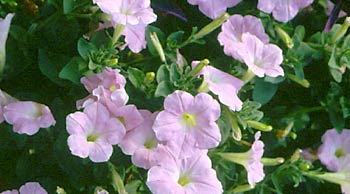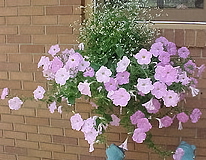Starting a Garden
Lawn Care
Spring Bulbs
Roses
Garden Books
Tools & Acc.
gardener status.
Please click on ads to support this site.
gardening in india, gardening in new zealand
| Petunias are so easy and common place that even the most avid
gardeners take them for granted. They have much to recommend
them besides their easy growing nature.
Petunias are readily available in six-packs or seeds in the spring and
come in nearly every shade of color except yellow. There are even some
fancy double varieties that have a much more complex blossom than the familiar
trumpet shape. Some are scented too. While there are hundreds of petunia varieties, they fall into four categories, based on flower size and growth habit.
Grandiflora petunias, the most popular type, produce the largest flowers, three to four inches across. Some have single blooms and some have ruffly double flowers, often with white fringes on veins. Some grandifloras have a cascading, horizontal growing habit that makes them more suitable for hanging baskets and window boxes, but most are upright plants that develop over the summer into mounds of flowers which are twelve to fifteen inches tall.
Multiflora petunias are more compact. They have smaller flowers than the grandifloras, but they make up for it with large numbers of blossoms. They are also available in single or double forms, though most are singles. Typically, they're massed together to create big splashes of color.
Milliflora petunias are miniature plants that produce abundant quantities of small flowers an inch and a half in diameter. They make good edging plants and are also attractive when grown with other flowering annuals in containers.
Petunias generally grow about 15 inches tall, but a newer type
called "wave" petunias or "spreading" petunias are only about six inches tall, but spread so rapidly that they cover a huge area by fall, six feet in diameter, provided they're watered and fertilized frequently. This makes them ideal for tumbling down a terraced hillside garden. They're also beautiful in hanging baskets and window boxes, where they hang two to three feet on each side. When grown in full sunlight, they are so covered by flowers that you hardly see any foliage.
Petunias can even survive very
light frosts and potted plants can grow inside provided they get several hours of direct sun. They will need considerable trimming by spring as the stems get overly long. Garden petunias sometimes drop their seeds and you may get a few "volunteer" plants the next spring. They are a perennials in climates where it never freezes.
Petunias look the best in masses of plantings of all the same color. With care, watering, fertilizing, and occasional trimming, they bloom all season. Give them some liquid fertilizer or manure tea about once a month.
Most gardeners buy them as six packs to start off the spring with some quick color. Petunias can be started from seed, but it takes a long while. They may prove difficult for beginning gardeners to start indoors. The advantages of starting petunias inside are that you have a wider choice of varieties from which to choose, and you can raise large quantities of plants for less money. But it takes ten to twelve weeks before petunias are big enough to transplant, so they need to be started early, January of February.
Because of their small size, petunia seeds can be difficult to work with. Not only are they very tiny, but they also need light in order to germinate. Pelleted seeds, seeds coated with little balls of starter fertilizer, are easier to handle, but are not always available.
Spread seeds sparingly on top of a container of sterile, damp potting soil. Water with a fine mist to wash them into the potting medium or press them in gently with your fingers before watering. Then cover the container with clear plastic to hold in moisture and store it in a bright, warm (70 to 85 degrees F) place--out of direct sunlight--until seeds begin to sprout. This usually takes seven to ten days after planting. Remove the plastic when seedlings emerge. Then relocate the container to a bright, but cooler place; 65 degree days, with night temperatures anywhere from 55 to 65 degrees.
When seedlings are three or four inches tall, it's time to transplant them into individual peat pots or packs that hold several plants each. Feed them every two weeks (weekly for wave petunias) with diluted liquid fertilizer. Harden off young plants by putting them outside on sunny, warm days. Then bring them back in at night for several days before planting them outdoors.
Wait until the soil warms and frost danger has passed before transplanting petunias. Space grandifloras and multifloras about twelve inches apart in full sunlight, or several inches closer together when planted in partial shade. Milliflora petunias can be spaced as close as four to six inches, but wave petunias should be planted at least two feet apart. Petunias must be planted much more closely together in containers in order to look full.
If it is hot when you transplant, provide some protection from midday sun for the first few days by sticking twigs with leaves next to them for shade. When grandifloras or multifloras grow about six inches tall, pinch the top buds back to encourage formation of flowering side shoots. Do not pinch millifloras or "spreading" petunias. Keep removing old spent blooms to encourage new flowers and prevent the plant from producing seeds. Butterflies and bees are attracted by petunias.
Petunias face relatively few diseases. They are so inexpensive it is often best just to pull out and replace any that look infected. Insects such as aphids and slugs sometimes attack petunia. Wash with insecticidal soap for aphids. Trap slugs by placing pots upside down next to the plants. The slugs will take refuge under them in the day and can be easily disposed of.
Another problem is harsh weather. Wind and heavy rain can make the large petunia flowers, the grandiflora, look beaten down and bedraggled. Trim damaged and overlong stems to keep the petunia fuller. The plants will grow out and look great again. Petunia |

 Petunia Links: When you have an abundance of petunias blooming in the garden, cut some of stems for use in floral arrangements. Remove any leaves that will be submerged in the vase.
Native to South America, the first petunia (Petunia multiflora) specimen was found at the mouth of the Rio de la Plata and was white in color. The original varieties were strong-growing plants that had trailing 2-3 inch stems and strong scents. Petunias are relatives of the tobacco plant and the annual flowering tobacco, nicotiana. 
|